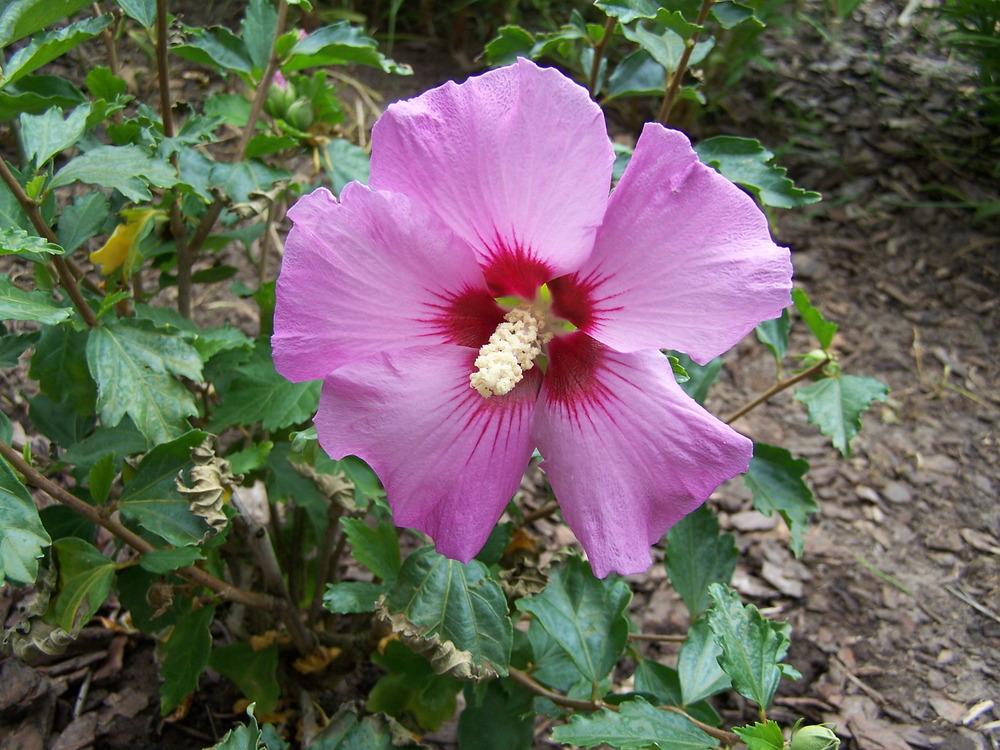I first noticed the hardy shrub called Rose of Sharon (Hibiscus syriacus) while traveling one midsummer across the southern plains. I saw it over and over again, blooming bravely in dooryard gardens despite the sizzling heat on the rough, wind-swept prairies. That's when I discovered that this large, summer-flowering shrub reliably brings pleasure and beauty, whatever the weather dishes out. That, to me, is the sign of a quality plant.

Luscious Bloom
Breeders have developed some lovely flower colors -- white, pink, red, violet, and lavender-blue -- available in single or double forms. Rose of Sharon sports her blossoms, which resemble those of other members of the mallow family, from mid- to late summer. I especially like the blue ones, such as 'Blue Satin' (although to my eye they are still more blue-violet than true blue, except in soft early morning light). Many of the double-flowered types seem almost more like oversized rose trees, with eye-stopping, multi-layered crepe paper flowers. The white-flowered cultivars are perfect for an all white summer "moon garden," and the many pinks and purples work well among the pastels of English-style gardens.
Also, the U. S. National Arboretum has introduced new cultivars in recent years that are triploids. The flowers are large, but they don't set seeds, so blooms are produced over a long period. 'Diana' is among the best of these introductions, with pure white flowers that remain open at night. The foliage is a waxy and dark green. 'Aphrodite' has rose-pink petals that are red at the base. 'Helene' has white flowers with deep red centers with streaks forming many-pointed stars. 'Minerva' has lavender-pink flowers with a red center.
If you plant Rose of Sharon in fall, don't be dismayed in springtime if it looks dead while surrounding plants are busily sprouting away. The three-lobed leaves emerge quite late. I, for one, am willing to accept this quirk because of the shrub's contribution to the summer garden. There is nothing to equal its stately presence amidst the daylilies, coneflowers, reblooming clematis, and sweet peas, with butterflies and hummingbirds all around it. Not bad for a low-maintenance, workhorse of a shrub!
Beyond a fresh layer of mulch in spring, routine care includes pruning (if desired) in late winter or very early spring. Some gardeners cut their shrubs back very hard - to 3 or 4 buds per shoot -- to control overall size and encourage larger blooms. Others simply take the laissez faire route and let their shrubs grow into their natural shape. This latter approach encourages more, smaller blossoms. The plant blooms on the new wood of the current season -- summer trimming means that you'll lose out on flowers.
While some gardeners find its persistent, woody seed pods an asset in the winter landscape, many gardeners shun Rose of Sharon - at least the old fashioned type - for the prolific, weedy offspring. This group will be won over by recent introductions, including triploid and tetraploid varieties, that set little if any seed.
As for pest problems, there are few. Japanese beetles love Rose of Sharon, so be prepared with your favorite means of beetle avoidance, be it traps, repellents, or grub control.
She's a hardy plant with gorgeous blossoms that needs little care -- what's not to love?